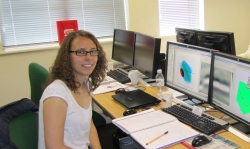Page path:
- Graduate School GLOMAR
- PhD student reports
- Other activities
- Zsuzsanna Tóth
Zsuzsanna Tóth
Report of GLOMAR PhD student Zsuzsanna Tóth about her participation in an AVOPAK course of SMT Kingdom in Croydon, London, UK, from 13-14 July 2011
AVOPAK is part of a seismic interpretation software, SMT Kingdom, and it offers an easy way to analyze the seismic attribute ‘Amplitude Variation with Offset’ (AVO) in seismic data. In reflection seismics, analysis of reflection amplitudes as a function of the offset, or more precisely the incidence angle of the seismic wave, can be used to detect changes in properties of reservoir rocks. AVO is known to be sensitive to variations in the gas/fluid content in the sediment pore space. My PhD aims at the investigation of shallow gas accumulations in the Baltic Sea, and in particular, I’m interested in finding quantification methods, which rely on acoustic and seismic data from gassy areas. AVO analysis is one of these methods, and although it is a well-developed technology for characterization of deep hydrocarbon reservoirs, it has never been applied to biogenic methane gas in shallow marine environments. To learn how I can analyze AVO in my data, I took the 2-day AVOPAK course at the training facility of SMT in Croydon, close to London. The course was very useful, as I could learn the whole process of the analysis, from loading the data into the software to the interpretation of the results. On the first day, we started with the theory and development of AVO and we were briefly introduced to the basics of the ‘AVO crossplots’ and different ‘AVO anomalies’. We then worked with a sample seismic dataset, we loaded the pre-stack data and inspected the seismic gathers for quality control. We tried out three AVO attribute computation and interpretation methods, which are possible with the software. On the second day, we created crossplots of the calculated AVO attributes and looked at the results together with the conventional seismic dataset. These methods are all very interactive and I was impressed how easy the analysis is with the software! Additionally, we also were introduced to ways of conditioning the data, so that the analysis will be correct. The trainer was very experienced and helpful, and I also got help from the other participants regarding a few questions about the specifics of my own dataset.
I would like to thank GLOMAR for the financial support. The course provided me a great opportunity to get started with seismic attribute analysis and I’m excited to see how it will work out on shallow gas in the Baltic Sea!
I would like to thank GLOMAR for the financial support. The course provided me a great opportunity to get started with seismic attribute analysis and I’m excited to see how it will work out on shallow gas in the Baltic Sea!



